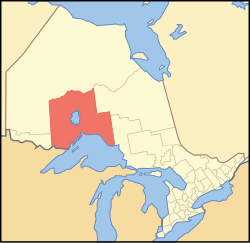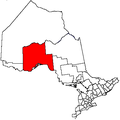Thunder Bay District | |
|---|---|
 Location of Thunder Bay District in Ontario | |
| Coordinates: 50°N088°W / 50°N 88°W | |
| Country | Canada |
| Province | Ontario |
| Region | Northwestern Ontario |
| Created | 1871 |
| Government | |
| • MPs | Eric Melillo (Conservative) Marcus Powlowski (Liberal) [1] Patty Hajdu (Liberal) |
| • MPPs | Bill Rosenberg (PC) Kevin Holland (PC) Lise Vaugeois (NDP) Sol Mamakwa (NDP) |
| Area | |
| • Land | 102,895.48 km2 (39,728.17 sq mi) |
| Population (2021) [2] | |
• Total | 146,862 |
| • Density | 1.4/km2 (4/sq mi) |
| Time zones | |
| East of 90° west | UTC-05:00 (Eastern) |
| • Summer (DST) | UTC-04:00 (EDT) |
| West of 90° west | UTC-06:00 (Central) |
| • Summer (DST) | UTC-05:00 (CDT) |
| Postal code span | |
| Area code | 807 |
| Largest communities [3] | Thunder Bay (109,140) Oliver Paipoonge (5,757) Greenstone (4,906) |

Thunder Bay District is a district and census division in Northwestern Ontario in the Canadian province of Ontario. The district seat is Thunder Bay.
Contents
- History
- Subdivisions
- Municipalities
- First Nations and their Reserves
- Unorganized areas
- Demographics
- Further reading
- See also
- References
- External links
Most of the district (93.5%) is unincorporated and part of the Unorganized Thunder Bay District.
